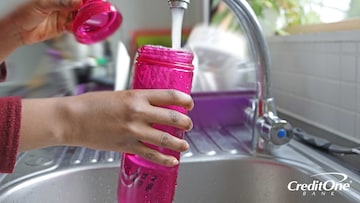
Wants vs. Needs: An Epic Budget Battle
May 11, 2018
Topics:
Saving MoneyA while back, just as the weather started to warm up, I came across a pair of white canvas tennis shoes in my size at the mall. “These will be perfect for summer,” I told myself as I lifted them off the rack and flipped one over to reveal the price sticker on the sole. Sweet—they were on sale. When I tried them on, they fit perfectly and were comfortable to boot, pardon the obvious footwear pun.

A while back, just as the weather started to warm up, I came across a pair of white canvas tennis shoes in my size at the mall.
“These will be perfect for summer,” I told myself as I lifted them off the rack and flipped one over to reveal the price sticker on the sole. Sweet—they were on sale. When I tried them on, they fit perfectly and were comfortable to boot, pardon the obvious footwear pun.
I was sold. Never mind that only days earlier I’d told myself I had too many shoes and not enough closet space. I needed this pair of sneakers.
Only I didn’t. I’d merely convinced myself that my want was a need. What I actually needed was to stay within my budget and gain more closet space. So, what possessed me to head for the register with a pair of kicks that were literally preventing me from meeting my needs?
At that moment, I was experiencing a release of dopamine in my brain directly attributable to my purchase. And, according to Columbia University professor of neurobiology David Sulzer in an article by Elle, the fact that the shoes were on sale gave me an even more intense jolt of this neurotransmitter that rewards the brain.
The next day, any remaining elation from my “shopper’s high” turned into regret as I tried to make room for my purchase in my overcrowded closet. It was then that I realized I had a new want: to pay more attention to my needs. Or was it a new need?
Wanting vs. Needing
The difference between these two concepts basically boils down to necessity. A want is a desire, but a need is something you require.
You need water to live, but unless you live somewhere where the local water source is contaminated, tainted, or nonexistent, you don’t need bottled water. Purchasing bottled water is a choice most of us make because we prefer it over tap water. Maybe we like the taste better, feel it’s safer, or perhaps it’s just more convenient in its portable bottled form. Whatever the reasons, bottled water is definitely a commodity we want—to the tune of $16 billion in 2016, with the average American spending over $100 per year on it, according to The Water Project.
That’s $100 those of us on tight budgets could allocate to help pay for other needs, like housing or food.
You need water to live, but unless you live somewhere where the local water source is contaminated, tainted, or nonexistent, you don’t need bottled water.
Why We Confuse the Two
There are relatively few things we truly need—from a purchasing perspective anyway. Yes, we need sleep, sunlight, breathable air, and it can be argued that in order to live healthy, productive lives we also need human interaction/companionship and a sense of purpose. But these are not things that can be purchased. Our basic needs that require payment distill down to items such as:
- Shelter
- Water
- Food
- Healthcare
- Clothing
- Transportation
It’s when we place too much emphasis on the variety of things that fall within these categories that we start to blur the lines between wants and needs. “I need clothing, so I must have this $300 cashmere sweater.” Or, “I need a way to get to and from work, therefore I have to own a brand-new 4x4 pickup with the deluxe sportsman’s trim package.”
Uh-ah. Both are wants, not needs. Is that to say we should never really want anything?
Of course not. Needs must be met for us to function in our daily lives, so they can’t be ignored. But wants interject fun, entertainment, variety, style, and more into our lives. The problem is that wants can quickly turn into budget-killers when we spend our money satisfying them before ensuring all of our needs have been met.
Putting it to Paper
Writing down what you’re actually spending your money on can help you distinguish wants from needs and prioritize them. Make a list of everything you purchased last month and how much you spent on each item. Then, go through each item one by one and place it under a WANTS or NEEDS column.
Some things, like gas and electricity, will be easy to categorize, as they’re clearly things you need to function in modern-day society. You may not need to use as much of them as you do, but you still need to use them.
The problem is that wants can quickly turn into budget-killers when we spend our money satisfying them before ensuring all of our needs have been met.
Other things, like groceries, will be more difficult to categorize. Yes, you need food, but do you need brand-name cereal instead of the less-expensive generic stuff? You need to eat lunch every day, but do you need to go out, or is going out something you want to do?
Tally up the totals to get a picture of how much you’re spending on your needs and wants. Also calculate how much you’re managing to save or invest each month for your future. Dividing each category by your monthly income will give you the percentages you’re spending on them.
Forbes recommends a 50-20-30 budget, with 50% of your income going toward paying for your needs, 20% going into savings and/or investments, and 30% for flexible spending, aka your wants.
Scratching Your Want Itch
If spending 30% (or less) of your income to purchase sneakers and other feel-good wants isn’t releasing enough dopamine into your brain, are you just expected to forgo that desirable sense of euphoria?
The good news is that a Gallup poll on spending and saving found that 59% of those surveyed enjoyed saving more than spending money. If you’re one of those people—or can figure out how to become one—you may be able to get the same kind of spending rush by watching your savings grow.
If you’re not, there are lots of other ways to increase dopamine besides spending your hard-earned money on wants. These include eating certain foods, exercising, getting more sunlight, listening to music—even touching loved ones.
So the next time you find yourself heading to the register with something you know you don’t need but are only buying for the rush, put it back on the shelf and take a vigorous walk in the sunlight while listening to your favorite playlist and holding the hand of someone you love. It’ll be better for you, your budget, and maybe even your closet-space situation.
Forbes recommends a 50-20-30 budget, with 50% of your income going towards paying for your needs, 20% going into savings and/or investments, and 30% for flexible spending, aka your wants.
After realizing he couldn’t pay back his outrageous film school student loans with rejection notices from Hollywood studios, Sean focused his screenwriting skills on scripting corporate videos. Videos led to marketing communications, which led to articles and, before he knew it, Sean was making a living as a writer. He continues to do so today by leveraging his expertise in credit, financial planning, wealth-building, and living your best life for Credit One Bank.



